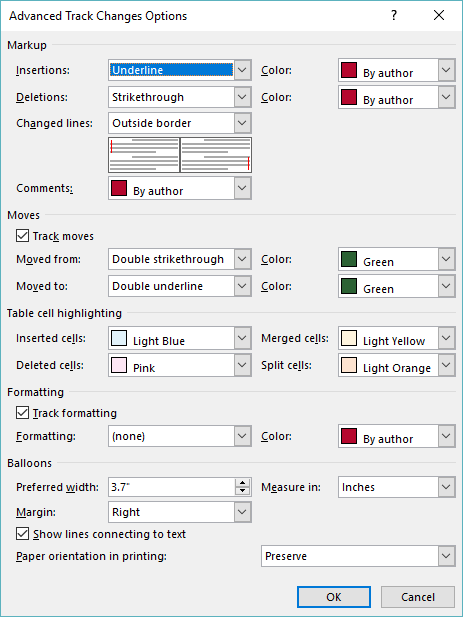Please Note: This article is written for users of the following Microsoft Word versions: 2007, 2010, 2013, 2016, 2019, and 2021. If you are using an earlier version (Word 2003 or earlier), this tip may not work for you. For a version of this tip written specifically for earlier versions of Word, click here: Changing How Changes are Noted in Word.
Written by Allen Wyatt (last updated September 18, 2024)
This tip applies to Word 2007, 2010, 2013, 2016, 2019, and 2021
If you use the Track Changes feature of Word, you know how your document looks as you make changes. Added text is shown in some different color, and deleted text is shown with a strikethrough or in balloons to the side of your text. You may want to change how Word shows your changed text. Fortunately, Word allows you great flexibility in this area.
To make your configuration changes, follow these steps if you are using Word 2007 or Word 2010:
If you are using Word 2013 or a later version, the steps are slightly different:

Figure 1. The Advanced Track Changes Options dialog box.
Both the Track Changes Options dialog box (Word 2007 and Word 2010) and the Advanced Track Changes Options dialog box (later versions of Word) are essentially the same. Using the controls in these dialog boxes, Word allows you to change a wide variety of options relative to how changes are tracked. These are the major sections of the dialog boxes:
It is important to note that All Markup (click the Display For Review tool in the Tracking group and select All Markup from the drop-down list) should be selected in order to display all the tracked changes you specified in the Advanced Track Changes Options dialog box.
WordTips is your source for cost-effective Microsoft Word training. (Microsoft Word is the most popular word processing software in the world.) This tip (6087) applies to Microsoft Word 2007, 2010, 2013, 2016, 2019, and 2021. You can find a version of this tip for the older menu interface of Word here: Changing How Changes are Noted in Word.

Learning Made Easy! Quickly teach yourself how to format, publish, and share your content using Word 2021 or Microsoft 365. With Step by Step, you set the pace, building and practicing the skills you need, just when you need them! Check out Microsoft Word Step by Step today!
When using Track Changes, Word normally notes the originator of a particular comment or change. This information can then ...
Discover MoreIf you want to configure how Word displays changes in your document, you may be at a loss as to where to start. This tip ...
Discover MoreEver wonder how to customize the way the Track Changes feature displays revision bars at the side of changed material? ...
Discover MoreFREE SERVICE: Get tips like this every week in WordTips, a free productivity newsletter. Enter your address and click "Subscribe."
There are currently no comments for this tip. (Be the first to leave your comment—just use the simple form above!)
Got a version of Word that uses the ribbon interface (Word 2007 or later)? This site is for you! If you use an earlier version of Word, visit our WordTips site focusing on the menu interface.
Visit the WordTips channel on YouTube
FREE SERVICE: Get tips like this every week in WordTips, a free productivity newsletter. Enter your address and click "Subscribe."
Copyright © 2026 Sharon Parq Associates, Inc.
Comments